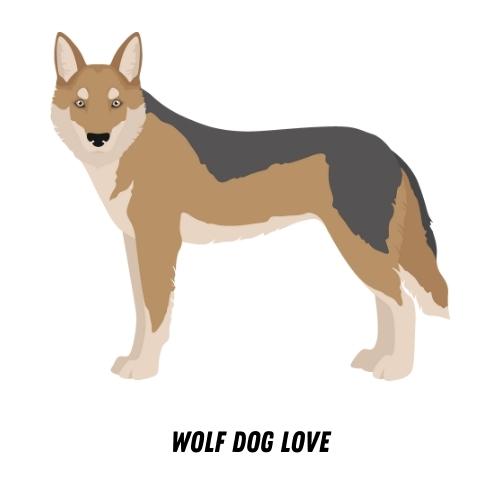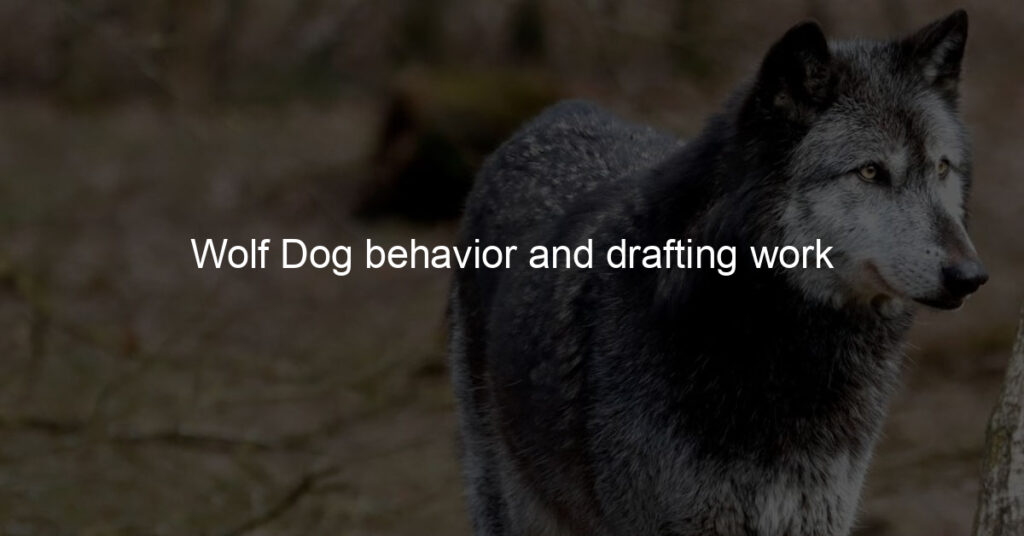If you’ve ever wondered whether your wolf dog is truly wild or just a domesticated cousin of the gray wolf, you’re not alone. Whether they are privately owned, part of a conservation program, or living in their natural habitat, these majestic animals have always been shrouded in mystery. Not only do they possess complex behavior patterns and pack dynamics that often defy human understanding but recently an exciting activity has also become associated with them – drafting work.
Are there ways to train Wolf Dogs to be trained for drafting work?
Wolfdogs are incredibly intelligent animals and have an amazing capacity for physical labor. This makes them ideal candidates for drafting work like pulling carts or even plowing fields.
Training wolfdogs to do this kind of work is relatively straightforward, but it requires a great deal of patience and consistency on the part of the handler. Training sessions should start with basic commands like “walk” and “stop” and gradually move up in difficulty as the dog’s skills improve.
Rewards should be used liberally, as well as lots of positive reinforcement when goals are achieved. With enough practice, your wolfdog can become a proficient drafter in no time!
What type of drafting work is it that Wolf Dogs do?
Wolf Dogs have long been renowned for their strength and unwavering loyalty, but many don’t realize that these canine heroes also possess a specific talent: drafting power!
Also known as carting or freighting, drafting is a job that involves dogs hauling carts, wheelbarrows, and sleds with goods and supplies. They excel at this type of work due to their agility and intelligence combined with their sheer physical might – after all, Wolf Dogs often weigh between sixty and one hundred pounds! It’s no wonder they have become invaluable throughout history to help humans transport items when on the move.
What can I do to help to prepare my Wolf Dog for drafting work?
Drafting with a wolf-dog can be an incredibly rewarding experience. To help prepare your wolf dog for drafting work, there are some important steps to take. Start by teaching your pup basic obedience commands such as ‘sit’, ‘down’, and ‘stay’.
Once these skills have been mastered, introduce them to any specialized drafting harnesses or carts you may use during training. Then, gradually increase the time and distance of walks with the pup in the harness or cart. Additionally, allow your wolf-dog to get used to navigating different types of terrain, like steep inclines or slippery surfaces.
Most importantly, always remember to provide plenty of positive reinforcement when they do good work! With patience and consistency, you should find that both you and your canine companion are ready for their first drafting job!
What are the advantages of the use of Wolf Dogs in drafting?
Wolf dogs, which are the result of crossbreeding wolves with various dog breeds, can be a great choice when it comes to using animals for drafting. Their impressive size and strength make them well-suited to tasks such as pulling large carts and sleds filled with goods, potentially replacing machines like small-engine tractors.
Additionally, wolf dogs are often hardier than traditional dogs and can cope better with extreme cold weather conditions, making them an excellent choice for living and working in colder environs such as the Arctic Circle.
The instinct of wolf-dog hybrids to pull also makes them incredibly valuable for their chosen task. So by utilizing the strength of these impressive animals, teams of people can travel far longer distances safely and quickly–an advantage that shouldn’t be overlooked!
Are there any dangers with the use of Wolf Dogs in drafting?
Wolf Dogs, a mix between the grey wolf and domestic dog, can be used for a variety of purposes such as sledding, skijoring, weight-pulling, and drafting. While these activities have been popular for decades, some experts warn about the use of Wolf Dogs in drafting.
It’s possible that their instinctive sense to pull in packs could lead to collisions with other vehicles. Moreover, different areas carry varying regulations when it comes to using animals for draft title standards, making it difficult to maintain control over them while on the road.
It is almost impossible to predict a Wolf Dog’s behaviors while in traffic, so owners should make sure they are familiar with local laws about their dogs before using them in any kind of public setting.
How can I become a licensed Wolf Dog drafting handler?
Becoming a licensed Wolf Dog drafting handler can be a challenging but rewarding career path. To start, you should become familiar with research and safety techniques when handling these types of animals, as one mistake can have serious implications for all involved.
Learning about breed-specific behavior and characteristics is also essential as each species has its own unique needs and behaviors. You’ll need to secure the necessary licensing for your location, which typically involves an examination process before you can begin.
Additionally, many handlers opt to gain experience working in an animal rehabilitation center or rescue organization to hone their skills and provide further learning opportunities related to wolves and wolfdogs. With dedication and education, becoming a licensed Wolf Dog Drafting Handler is achievable – so let’s get started!
What kind of environment is ideal for Wolf Dog drafting work?
Wolf Dog drafting requires clear heads and precise execution, so the ideal environment puts those working on it at ease. You want an environment with plenty of natural light to help reduce eyestrain, comfortable furniture to encourage relaxation and concentration, and a quiet atmosphere for concentration.
A room without distractions or outside noise will ensure that everyone can focus without being interrupted or taking their minds off task. Additionally, having snacks, coffee, and drinks nearby can keep energy levels up so that creative processes have enough fuel to drive them forward!
Can Wolf Dogs be used to help with drafting work?
While the idea of using wolf dogs for drafting work might seem radical, it does have some basis in reality. Draft animals are usually used to pull sleds and carts, and since wolves have a strong pack mentality with the alpha being the leader, they could be trained to work together to assist with specific tasks.
Wolves are often seen as powerful and courageous creatures, which makes them ideal candidates for this type of hard labor. Furthermore, wolf dogs tend to be active animals that require a lot of activity and stimulation; this provides an outlet for their physical energy while also allowing them to hone their skills in a manner that’s beneficial to their owners. While this isn’t commonplace yet, the idea of utilizing wolf dogs for drafts has definite potential and is worth considering further.
What kinds of characteristics are Wolf Dogs need for drafting work?
Wolf Dogs are a unique breed of canine, experiencing a surge in popularity over the last few decades. Their combination of wolf and dog traits makes them perfectly suited for working alongside humans, allowing them to lend their incredible strength to tasks like drafting.
To be successful, these dogs need certain characteristics as part of their core makeup: loyalty and obedience to their handlers; strength and endurance; and a strong work ethic that allows them to take on difficult tasks. Some more modern Wolf Dogs are even capable of understanding hours of commands, making them ideal candidates for drafting activities.
If you’re looking for the perfect companion to help with tasks like hauling freight or pushing carts, discovering Wolf Dog characteristics could be your ticket to success.
Do I have to use my personal Wolf Dog for drafting work?
The great thing about having a wolf dog is that they are so versatile! Whether you need a hiking companion or some help with pulling your sled, they will be up for the challenge.
However, there are special considerations to make when using your wolf dog for drafting work. It’s important to consider their size and strength before taking on any such tasks, as well as the general safety of the animal. Additionally, it’s always wise to have specialized harnesses and equipment so that you can minimize strain or injury to your four-legged loyal friend.
Ultimately, whether you decide to use your wolf dog for drafting work or not is completely up to you and dependent on the individual determination of both its capability and temperament.
What are the most frequent mistakes to avoid in Wolf Dog drafting training?
If you’re embarking on the journey of training your wolf dog, there are a few mistakes you should be sure to avoid. First, it’s vital to ensure that you’re setting realistic expectations around what your pup can accomplish.
Remember, they will need consistent recognition and reinforcement when they do something right and patience when they misunderstand. Secondly, it’s also important not to be overly strict with consequences when your pup doesn’t properly adhere to instructions as these could hinder their ability to learn effectively as well as damage their trust in you as an authority figure.
Lastly, always strive for consistency in terms of the language used for tasks, the timing for rewards and discipline, and physical contact for various behaviors. Doing this will make all the difference in helping them understand what is expected of them and rewarding or correcting them appropriately!
Conclusion
Wolves and wolf dogs are truly magnificent and captivating animals, capable of a wide range of emotions just like us. Many aspects of their behavior are still a mystery, but it is plain to see that they have a strong connection to their owner through trust. Drafting work for wolf dogs isn’t easy, as it requires patience, dedication, and consistency from the handler for it to be successful.








